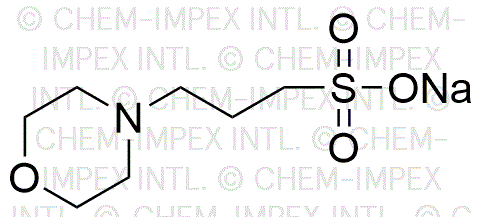MOPS sodium salt is widely utilized in research focused on
- Biological Buffers: It serves as an effective buffering agent in biological and biochemical research, maintaining stable pH levels in cell culture and enzyme reactions.
- Protein Studies: Commonly used in the formulation of buffers for protein electrophoresis, it helps researchers analyze protein behavior under various conditions.
- Pharmaceutical Development: In drug formulation, it aids in stabilizing active ingredients, ensuring consistent efficacy and safety in pharmaceutical products.
- Diagnostic Applications: Utilized in diagnostic kits, it enhances the reliability of assays by providing a controlled environment for biochemical reactions.
- Environmental Testing: Employed in environmental science, it helps maintain pH in samples during analysis, ensuring accurate results in water quality testing.
General Information
Properties
Safety and Regulations
Applications
MOPS sodium salt is widely utilized in research focused on
- Biological Buffers: It serves as an effective buffering agent in biological and biochemical research, maintaining stable pH levels in cell culture and enzyme reactions.
- Protein Studies: Commonly used in the formulation of buffers for protein electrophoresis, it helps researchers analyze protein behavior under various conditions.
- Pharmaceutical Development: In drug formulation, it aids in stabilizing active ingredients, ensuring consistent efficacy and safety in pharmaceutical products.
- Diagnostic Applications: Utilized in diagnostic kits, it enhances the reliability of assays by providing a controlled environment for biochemical reactions.
- Environmental Testing: Employed in environmental science, it helps maintain pH in samples during analysis, ensuring accurate results in water quality testing.
Documents
Safety Data Sheets (SDS)
The SDS provides comprehensive safety information on handling, storage, and disposal of the product.
Product Specification (PS)
The PS provides a comprehensive breakdown of the product’s properties, including chemical composition, physical state, purity, and storage requirements. It also details acceptable quality ranges and the product's intended applications.
Certificates of Analysis (COA)
Search for Certificates of Analysis (COA) by entering the products Lot Number. Lot and Batch Numbers can be found on a product’s label following the words ‘Lot’ or ‘Batch’.
*Catalog Number
*Lot Number
Certificates Of Origin (COO)
This COO confirms the country where the product was manufactured, and also details the materials and components used in it and whether it is derived from natural, synthetic, or other specific sources. This certificate may be required for customs, trade, and regulatory compliance.
*Catalog Number
*Lot Number
Safety Data Sheets (SDS)
The SDS provides comprehensive safety information on handling, storage, and disposal of the product.
DownloadProduct Specification (PS)
The PS provides a comprehensive breakdown of the product’s properties, including chemical composition, physical state, purity, and storage requirements. It also details acceptable quality ranges and the product's intended applications.
DownloadCertificates of Analysis (COA)
Search for Certificates of Analysis (COA) by entering the products Lot Number. Lot and Batch Numbers can be found on a product’s label following the words ‘Lot’ or ‘Batch’.
*Catalog Number
*Lot Number
Certificates Of Origin (COO)
This COO confirms the country where the product was manufactured, and also details the materials and components used in it and whether it is derived from natural, synthetic, or other specific sources. This certificate may be required for customs, trade, and regulatory compliance.


